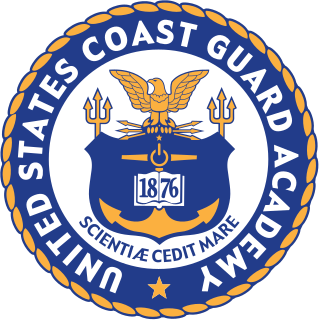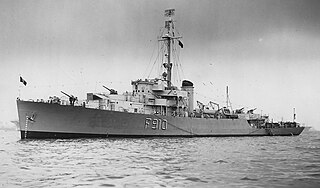
The United States Merchant Marine Academy, one of the five United States service academies, is located in Kings Point, New York. It is charged with training officers for the United States Merchant Marine, branches of the military, and the transportation industry. Midshipmen are trained in marine engineering, navigation, ship's administration, maritime law, personnel management, international law, customs, and many other subjects important to the task of running a large ship.

William Veazie Pratt was an admiral in the United States Navy. He served as the President of the Naval War College from 1925 to 1927, and as the 5th Chief of Naval Operations from 1930 to 1933.
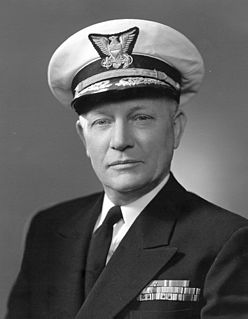
Merlin O'Neill served as the tenth Commandant of the United States Coast Guard from 1 January 1950 to 1 June 1954.

Admiral Samuel Shelburne Robison CB, USN was a United States Navy officer whose service extended from the 1890s through the early 1930s. He held several major commands during World War I, and from 1928-1931 served as Superintendent of the United States Naval Academy. In 1933, Admiral Robison also founded a Naval Preparatory Academy in Pine Beach, New Jersey called Admiral Farragut Academy.
Commodore was an early title and later a rank in the United States Navy, United States Coast Guard and the Confederate States Navy. For over two centuries, the designation has been given varying levels of authority and formality.
This article covers the organization of the United States Coast Guard.

Alfred Wilkinson Johnson was a career officer of the United States Navy who served in the Spanish–American War and World War I, commanded several ships, and served as Director of Naval Intelligence, reaching the rank of Vice Admiral. He retired in December 1940.
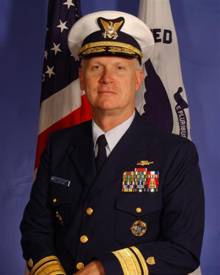
Timothy S. Sullivan is a retired rear admiral in the United States Coast Guard who served as the Deputy Commander, Pacific Area Coast Guard Defense Forces West. He was assigned as Commander of the Pacific Maintenance and Logistics Command, but was detached from those duties while serving as Deputy PACAREA. He has also served as the First Coast Guard District Commander and Commander, Maritime Defense Command One as well as the Senior Military Advisor to the Secretary of Homeland Security serving as the primary coordinator between the Departments of Defense and Homeland Security as well as operational advisor to the Secretary during Hurricanes Katrina and Rita.

Rear Admiral John Scott Burhoe was the 39th Superintendent of the United States Coast Guard Academy in New London, Connecticut from 2007 to 2011. His previous position was Assistant Commandant for Governmental and Public Affairs at Coast Guard Headquarters in Washington, D.C. He earned his commission after graduating from Officer Candidate School in 1977. He is the first non-Academy graduate to lead the school in at least one hundred years.
Hispanics in the United States Naval Academy account for the largest minority group in the institution. According to the Academy, the Class of 2009 includes 271 (22.2%) minority midshipmen. Out of these 271 midshipmen, 115 are of Hispanic heritage. In 2004, of the total of 736 female midshipmen, 74 (10%) of them were of Hispanic descent.
Rear Admiral William Onahan Gallery was a United States Navy admiral — one of three brothers who became United States Navy admirals. A graduate of the United States Naval Academy, he was a naval aviator who served with distinction in combat during World War II.
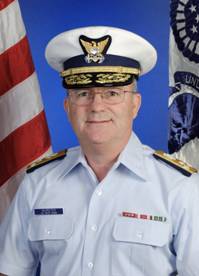
Charles D. Wurster is a retired Vice Admiral in the United States Coast Guard who last served as the Commander, Pacific Area and Commander, Defense Force West. He is now retired from the Coast Guard, is the President/CEO of the Port of San Diego, and serves as national commodore of the Sea Scouting division of the BSA.

Louis McCoy Nulton was a four-star admiral in the United States Navy who was superintendent of the U.S. Naval Academy from 1925 to 1928 and commander of the Battle Fleet from 1929 to 1930.

Erroll M. Brown is a retired rear admiral in the United States Coast Guard. Brown was the first African-American promoted to flag rank in the Coast Guard.
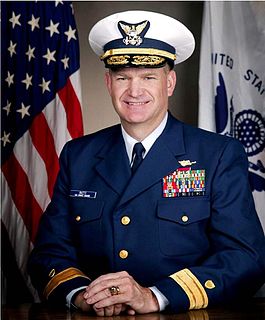
Steven H. Ratti is a former United States Coast Guard officer. He is the son of retired U.S. Coast Guard officer Rear Admiral Ricardo Ratti, who was born in 1922 and is a member of the USCGA Class of 1944. They are the only Coast Guard Academy graduate father and son pair to reach the rank of rear admiral in the U.S. Coast Guard.

Thomas Jones Senn was a decorated United States Navy officer with the rank of rear admiral. He was a recipient of the Navy Cross.
Harold G. Bradbury was a rear admiral in the United States Coast Guard.
Arthur B. Engel was a rear admiral in the United States Coast Guard. At different points in his maritime career, he served as Superintendent of the United States Coast Guard Academy at New London, Connecticut and as Superintendent of the United States Merchant Marine Academy at Kings Point, New York.

Vice Admiral James A. Hirshfield was the sixth Assistant Commandant of the United States Coast Guard. During World War II he was the commanding officer of the USCGC Campbell (WPG-32) during a battle with German U-boats, earning the Navy Cross.



